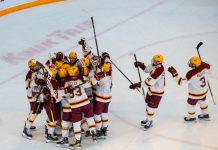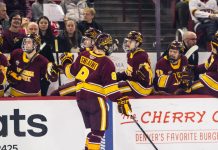T.R. Moreau doesn’t even remember it happening.
Fifteen minutes, two seconds into the first period of Wisconsin’s game against Minnesota-Duluth Jan. 9, Moreau and Duluth forward Joe Rybar followed the puck into the corner. Rybar checked Moreau into the boards, and the Badger winger’s neck whiplashed into the glass.
Moreau fell to the ice and lay there for 15 minutes without moving, as medical personnel attended to him.
“All I could hear was our trainer [Mike Johnson] going, ‘Wake up, wake up,'” Moreau said. “I could kind of hear him, but I couldn’t open my eyes yet. As I opened [them] up, I’m like, ‘Where am I?’ and ‘What’s going on?'”
The 5-10 sophomore from Rockford, Ill., said Johnson explained to him where he was, and Moreau started to piece together what was going on. But three weeks later, he still can’t remember what happened.
“I don’t remember anything playing-wise,” he said. “I remember the warm-ups and the dedication they made to coach [Jeff] Sauer. That’s the last thing I remember.
“They say the memory might come back, it might not.”
X-Rays on Moreau’s neck came back negative, and he eventually returned to the Dane County Coliseum to see the end of the game.
But Moreau had suffered a concussion, his second of the season, in fact. He also fell to a concussion, albeit a much less severe one, against Alaska-Anchorage in the first week of the Western Collegiate Hockey Association schedule.
The team has also lost the services of senior Brad Englehart twice this season with concussions. It is now to the point of weighing on Sauer’s mind.
“It’s a real concerning thing, especially when you get a T.R. Moreau, who’s had two now this year, and a Brad Englehart who’s had two,” he said. “The real problem with the concussion is the only cure really is the player telling us when he feels better, and when he really feels right.”
The actual definition of a concussion, according to Johnson — in his eighth year as head athletic trainer for Wisconsin hockey — is an agitation and irritation of the brain that causes a change in mental status, but rarely involves a loss of consciousness.
How to grade the severity of the injury, however, depends on who you talk to.
“There’s something like 26 or 28 different guidelines as to how to grade the severity of a concussion right now, from different medical groups,” he said. “There’s not a lot of consensus on what they are and how you determine how bad they are.”
Moreau said the aftermath of the concussion is noticeable.
“After that, your head’s out of sorts,” he said. “Sometimes you have headaches; you get lightheaded if you walk up stairs; it’s really hard to concentrate. “[Badger defenseman] Craig Anderson said it best when he said it’s like watching yourself through a TV, but it’s you. You’re looking at it, but you don’t seem like you’re there.”
Even though the number of concussions on the Badger team is rising, Sauer said there’s not a lot anyone can do to prevent these types of head injuries.
“The more I talk to the doctors, the more we discuss things, the actual concussion really has not a lot to do with the helmet the guys are wearing or the mouthguard or anything,” he said. “It’s just if guys get banged hard enough, with the way the brain sits in the skull, if it’s banged the right way, it’s possible to get a concussion.”
One part of the debate on the emergence of head injuries is the equipment players wear. By NCAA rules, players must wear a helmet with a face shield and a mouthguard when on the ice. But Johnson said the debate goes further.
“There’s a lot more to it than just those two things,” he said. “T.R. had his mouthguard in, he had his helmet on, it was all in place, and yet still he had a significant head injury.”
In an effort to be able to take action to reduce injury, the WCHA three years ago began keeping track of every injury that takes place during a practice or game. Each league school submits confidential data to a company which analyzes the detailed information.
“The purpose of this recording system is, under some objective system, to try to look at all that and then come up with patterns and come up with what’s happening,” Johnson said. “Then, hopefully, we can advise the coaches and the administrators and people who make the rules on this is what we’re seeing and this is how they’re happening.
“We feel good that we’re trying to do something. It’s not by any means perfect, but we feel that it’s the best system out there to utilize.”
Sauer said the recent rise may be due to the new monitoring. “We’re keeping track of them more,” he said. “There may have always been a lot of concussions, but people just didn’t talk about it. Now, the last three, four years, we’ve been keeping track of them.”
But Johnson said the rise in occurrences this year may just be due to a cycle. “Injuries, in general, of all kinds, go in cycles,” he said. “So some years, you get a lot of one type of injury and very few of others. This year, we’re getting a lot of concussions — not a lot, but more than we have in the past.”
For Moreau, a concussion is certainly not the worst he could have faced. Take Boston University’s Travis Roy, for example. In October of 1995, in his first collegiate shift, Roy went head-first into the boards while following a check. A cracked fourth vertebra left him paralyzed from the neck down.
Moreau, in fact, met Roy while in prep school. Roy told Moreau what happened to him.
“He mentioned that he really didn’t know what was going on, and he thought he could move stuff — in his own mind,” Moreau said. “And [in my case] when they were like, ‘Can you move your arms and legs?’ I thought I moved them. I did move them.
“But they started putting me on the back board and stretcher, and I’m like, ‘Did I think I moved them and not move them, what’s going on?’ Then I started thinking, ‘Oh God, that’s what he was talking about before.'”
But Moreau, who continued his rehabilitation Jan. 29 by returning to practice with the team for the first time since the injury, was fortunate in that he only had a concussion. Still, it keeps him out of what he loves to do.
“It’s pretty frustrating, to be honest,” he said. “The thing you love most in your life, you can’t do. It’s been pretty hard so far to see everyone play and you’re not able to.”
As far as getting back in uniform for the team, Moreau feels helpless. “It’s not something I can do, it’s not in my control at all,” he said. “There’s not like a certain exercise I can do or a test I can pass. I just have to wait.
“Patience is a virtue, but I don’t have it right now.”


